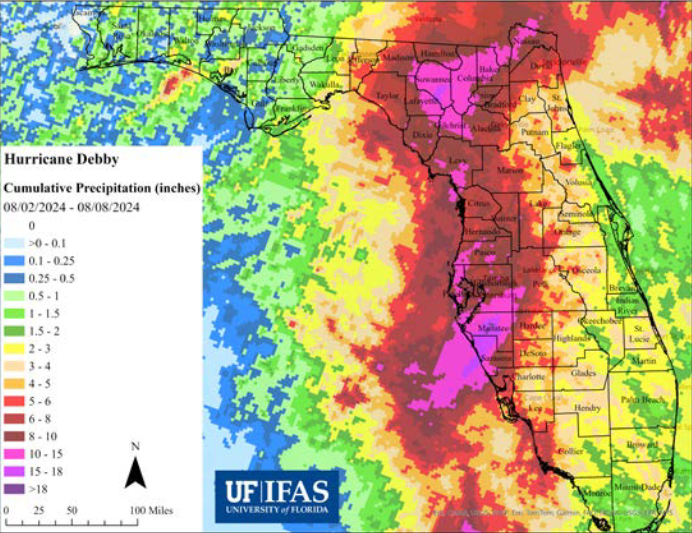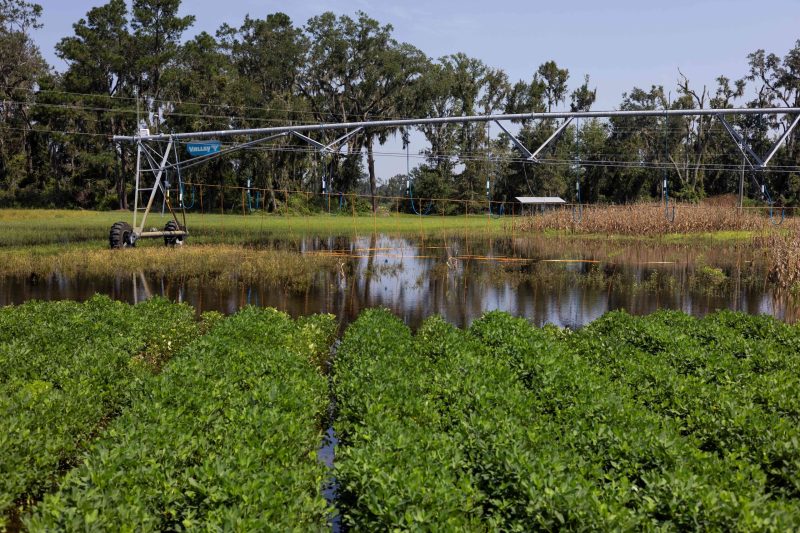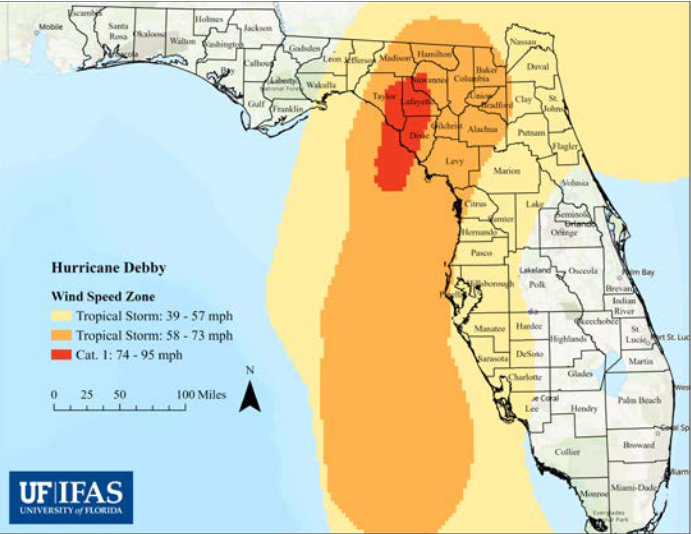Megan Winslow, Public Relations Specialist, UF/IFAS Communications

Figure 1. Cumulative precipitation totals in Florida (08/02-
08/08, 2024). Source: NOAA National Weather Service
Hurricane Debby formed as a tropical depression on August 3, 2024 near Cuba, before moving into the Gulf of Mexico and strengthening into a tropical storm.. It gradually intensified, attaining Category 1 strength on August 4th prior to making landfall near Steinhatchee, Florida (Taylor County) on August 5th. Hurricane Debby then moved northeast, impacting the Southwestern Peninsula and then made landfall in North Central Florida before crossing into Southeast Georgia, and later North and South Carolina before reentering the Atlantic Ocean.The UF/IFAS Economic Impact Analysis Program rapidly assesses the impacts to Florida agriculture following extreme weather events.
The Preliminary Assessment of Agricultural Losses and Damages Resulting From Hurricane Debby report was released this week. The report estimates a credible range of losses. This range will be narrowed in a final report released in the coming months. The estimate includes the value of shellfish and finfish aquaculture but does not include the value of damage to stored agricultural inputs like fertilizer and feed, stored harvested products or infrastructure.
The agricultural production losses Florida experienced due to Hurricane Debby have an estimated value between $93.7 million and $263.2 million, according to a preliminary UF/IFAS Economic Impact Analysis Program (EIAP) report based on producer surveys. The Category 1 storm affected more than 2.2 million acres of agricultural lands — 68% of it used for grazing. By comparison, Hurricane Idalia, a Category 3 storm that impacted 3.5 million acres last year, caused agricultural production losses valued at $276 million. “Hurricane Debby’s path through the state largely mirrored Hurricane Idalia’s; however, no two storms are alike,” said Christa Court, UF/IFAS EIAP director. “While Idalia brought more intense winds, Debby was a wetter storm with more agricultural lands experiencing flooding.”

Intense rainfall from Hurricane Debby flooded a peanut field at the UF/IFAS North Florida Research and Education Center – Suwannee Valley, in Live Oak on August 8, 2024. Credit: Tyler Jones, UF/IFAS
–

Figure 1. Wind swath pattern of Hurricane Debby as it
impacted Florida. Source: NOAA National Hurricane Center
Suwannee, Taylor, Lafayette and Dixie counties bore the brunt of Hurricane Debby, but tropical storm-force winds and heavy rain extended as far south as Lee County, according to the report. Parts of Northern and Southwest Florida, including Suwannee, Manatee and Sarasota counties, experienced more than 15 inches of rain between August. 2nd and 8th. Across commodity groups, 41.6% of the impacted agricultural land experienced low-intensity weather conditions, 56.3% experienced moderate-intensity weather conditions and 2.1% experienced high-intensity weather conditions, according to the report. The hurricane damaged agricultural lands that collectively generate more than $3 billion worth of products each year, according to the report.
The estimated range of production losses for the current growing or marketing season for select commodity groups include:
-
Animals and animal products: $41.1 million to $98.5 million.
– -
Field and row crops: $19.3 million to $53.1 million.
– -
Greenhouse/Nursery: $15.0 million to $53.6 million.
–
Production loss estimates are based on survey responses specific to Hurricane Debby, as well as observations from past events, and these loss percentages can vary widely across operations – even within the same commodity group, Court said. “In the early days and weeks after a hurricane event, many agricultural operations are unsure of the true extent of impacts of the event on their growing operations,” she said. “Also, many crops within the vegetables, melons and potatoes commodity group were out of season or not yet planted, and many growers experiencing zero or minimal impacts on their operations do not report this information. We will continue to collect information specific to Hurricane Debby, which will improve the accuracy of these estimates in our final report.”
The UF/IFAS EIAP report relies heavily on agricultural producers’ survey responses. In addition to improving public understanding of the economic importance of agriculture, the information collected is used to improve the industry’s resilience by informing disaster response and recovery, policy discussions, and emergency planning exercises.
The EIAP will continue to collect data related to Hurricane Debby through 2025 via the Assessment of Losses and Damages to Florida Agriculture from Hazard/Disaster Events tool. The information supplied will be used in the program’s final report on the storm, which is expected by the end of the year. It will also support broader studies of extreme weather events’ effect on agriculture and inform assessments of future events.
Access the Preliminary Hurricane Debby Report on the UF/IFAS Economic Impact Analysis Program website.
–
Para accesar a este contenido en español, por favor utilice este enlace.
- Federal Estate Tax and Gift Tax Limits Announced For 2026 - December 19, 2025
- Why Do I Have So Many Open Cows? Causes of Reproductive Failure - December 19, 2025
- Wiregrass Cotton Expo Offers Resources, Research, & Real Solutions for Growers in Southeast – January 22 - December 19, 2025

